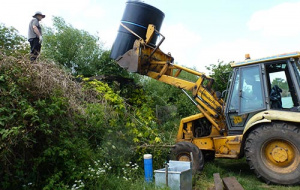Feeding mind and body
 What does an experimental scientist do over lockdown?
What does an experimental scientist do over lockdown?
Like most colleagues there is a continual run of meetings, classes and tutorials making us slaves to the tyranny of Zoom, Teams and the like. Through all of this, however, those of us dedicated to hands on experiments have still managed to keep up with our research and teaching in the laboratories. In my own case I’ve been helping research students to align spectrometers, connect up samples and set up chemical processes. My research group has been developing some new transparent conducting layers made with carbon nanotubes which we recently patented and are hoping to license to companies soon.
I run two large laboratories for the 2nd and 3rd year undergraduates and we are determined that the Oxford course should still prepare our students to measure things and interpret what they find. COVID-19 restrictions have meant that very few students could do this in person and so most have had to do it remotely. I spent much of August and September being filmed doing the experiments myself and collecting typical data sets (i.e. the best, because I know what I am doing and had time and help to make sure that it really was done perfectly!). Then came new instructions for how to make the most of the data. With a team of 12 demonstrators to give one-to-one guidance we have delivered almost a complete year of practical courses with what feels like a good approximation to proper experimental work. Several of the working practices we have introduced have been significant improvements and will carry on in future.
What about life away from the lab? My big project this year was to help Oxford become a bit more self-sufficient in food production. This is a grandiose way to say that I am an allotment holder on Port Meadow. We all need water to grow our fruit and vegetables, and with global warming we need more of it. This summer’s plan was to deliver water on tap to all the 160 plots and use some basic physics to make it work. In September 2019 we had drilled a borehole into the river Thames basin. As the first lockdown began to ease I installed a waterpump powered by some large solar panels to pump water up to a raised storage tank. With a group of plotholders we built a water distribution network with over 1km of large and small bore pipes distributing water to 30 troughs and taps. I spent a lot of time practicing my basic plumbing skills but it was a delight to get out in the sunshine and do something practical. As a result, everyone can connect up a hosepipe to a tap within 20m of their plot to deliver water to grow the perfect strawberries, sweetcorn, asparagus and other delights. Lots of people contributed to this, digging, plumbing, lifting and generally sorting things out, but ultimately it was my design with the layout designed for optimum efficiency. As we were nearing completion Judy, my wife, asked what if after all of the effort and expense, it doesn’t work. I just looked at her quizzically and said of course it will, I’ve done the maths.
 (Image at top of the page shows our 3 ton water storage tank being lifted onto a carefully camouflaged shipping container. In the foreground the blue pipe comes up from our borehole and next to it is one of the galvanised water troughs.)
(Image at top of the page shows our 3 ton water storage tank being lifted onto a carefully camouflaged shipping container. In the foreground the blue pipe comes up from our borehole and next to it is one of the galvanised water troughs.)
Professor Robin Nicholas, Tutorial Fellow and Praelector in Physics, Professor of Physics and Financial Advisor
This feature was adapted from one first published in Issue 13 of The Martlet; read the full magazine here or explore our back catalogue of Martlets below:
Published: 26 May 2021
















